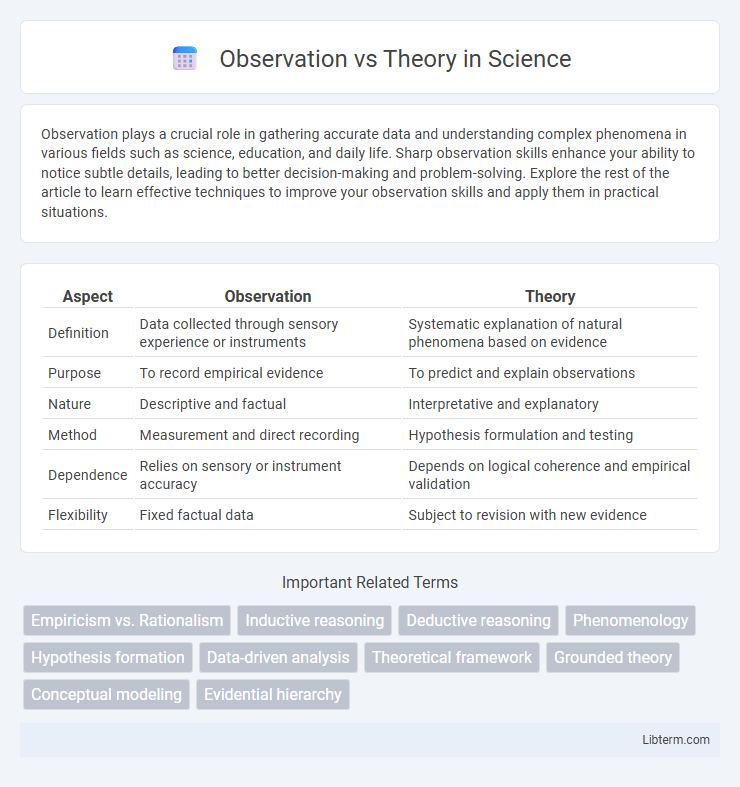Observation plays a crucial role in gathering accurate data and understanding complex phenomena in various fields such as science, education, and daily life. Sharp observation skills enhance your ability to notice subtle details, leading to better decision-making and problem-solving. Explore the rest of the article to learn effective techniques to improve your observation skills and apply them in practical situations.
Table of Comparison
| Aspect | Observation | Theory |
|---|---|---|
| Definition | Data collected through sensory experience or instruments | Systematic explanation of natural phenomena based on evidence |
| Purpose | To record empirical evidence | To predict and explain observations |
| Nature | Descriptive and factual | Interpretative and explanatory |
| Method | Measurement and direct recording | Hypothesis formulation and testing |
| Dependence | Relies on sensory or instrument accuracy | Depends on logical coherence and empirical validation |
| Flexibility | Fixed factual data | Subject to revision with new evidence |
Introduction to Observation and Theory
Observation involves systematically gathering empirical data through sensory experience or instruments to understand phenomena, serving as the foundational step in scientific inquiry. Theory consists of structured explanations and models derived from observed data, providing predictive frameworks that guide further observations and experimentation. The dynamic interplay between observation and theory advances knowledge by continuously refining hypotheses and validating scientific concepts.
Defining Observation in Science
Observation in science refers to the systematic collection of data through the senses or instruments to record phenomena objectively and accurately. It serves as the foundational step in the scientific method, enabling researchers to gather empirical evidence that supports or refutes hypotheses. Unlike theory, which provides explanations and predictive frameworks, observation involves direct interaction with variables, ensuring that scientific conclusions are grounded in measurable and reproducible results.
Understanding Theories: Foundations and Functions
Theories provide structured frameworks that organize and explain patterns observed in empirical data, offering predictive power beyond mere observation. They establish foundational principles that guide the interpretation of complex phenomena, enabling systematic testing and refinement through ongoing observation. Understanding theories involves recognizing their role in transforming raw observations into coherent explanations that advance scientific knowledge.
Key Differences Between Observation and Theory
Observation involves the direct collection of empirical data through sensory experience or measurement, serving as the foundational evidence for scientific inquiry. Theory represents a systematic framework of concepts and principles that explains and predicts phenomena based on accumulated observations and tested hypotheses. While observation provides raw data, theory offers interpretative models that guide further investigation and understanding.
The Role of Observation in Scientific Discovery
Observation serves as the foundational step in scientific discovery by providing empirical data that grounds hypotheses and theories in reality. Precise and repeatable observations enable scientists to identify patterns, formulate predictive models, and validate or refute theoretical frameworks. The iterative process between observation and theory refinement drives scientific progress and enhances understanding of natural phenomena.
How Theories Shape Scientific Understanding
Scientific understanding evolves as theories provide frameworks that organize observations into coherent explanations and predictions. Theories guide the interpretation of data by offering hypotheses that can be tested, refined, or refuted, enhancing the depth and scope of knowledge. This dynamic interplay between theory and observation drives scientific progress, enabling the formulation of laws and models that reflect the underlying realities of natural phenomena.
The Interdependence of Observation and Theory
Observation and theory are fundamentally interdependent; observations provide empirical data that guide the development and refinement of scientific theories, while theories offer interpretative frameworks that shape the collection and understanding of observations. This reciprocal relationship drives scientific progress by ensuring that theories remain grounded in observable evidence and observations are meaningfully contextualized. Effective scientific inquiry relies on this dynamic interplay to enhance predictive accuracy and deepen knowledge across disciplines.
Limitations of Observation and Theory
Observation is limited by sensory constraints and can be affected by bias, leading to incomplete or inaccurate data collection. Theory faces limitations in its assumptions and simplifications, often requiring revision when new evidence contradicts established models. Both observation and theory depend on the context and tools available, which influence their accuracy and applicability in scientific inquiry.
Real-World Examples: Observation vs Theory
Observation in science involves collecting empirical data through direct sensory experience or instruments, such as Galileo's telescope-based observations of Jupiter's moons, which challenged existing geocentric models. Theory provides a conceptual framework explaining these observations, exemplified by Newton's law of gravitation that mathematically described the motions observed by astronomers. Real-world examples demonstrate the iterative relationship where observations, like the bending of light near the sun in Eddington's 1919 expedition, confirmed Einstein's theory of general relativity, revolutionizing physics.
Conclusion: Balancing Observation and Theory in Research
Effective research demands a balanced integration of observation and theory, where empirical data validates theoretical frameworks and theories guide the interpretation of observations. Relying solely on observation risks empirical inaccuracies, while exclusive dependence on theory may lead to ungrounded assumptions. A rigorous conclusion emerges when systematic observation aligns with robust theoretical analysis, enhancing the credibility and depth of research findings.
Observation Infographic

 libterm.com
libterm.com